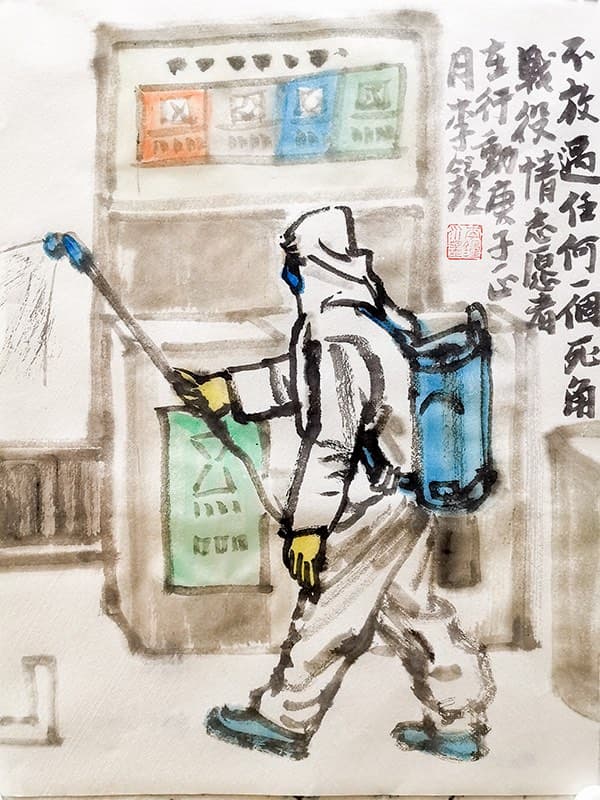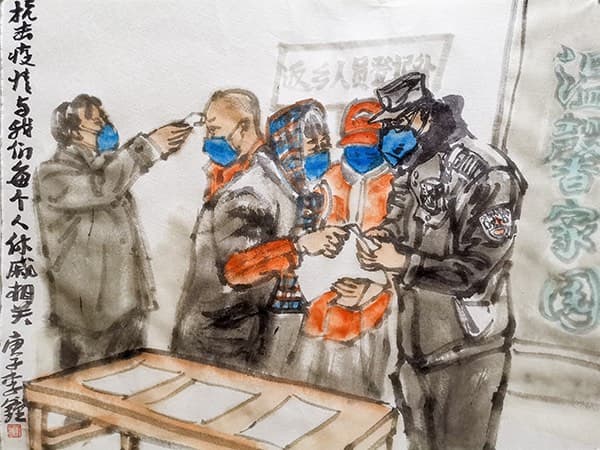COVID-19: We Won’t Go Back to Normal, Because Normal Was the Problem
by Vijay Prashad, Consortium News:

When a global pandemic strikes, the private-sector austerity model simply falls apart, writes Vijay Prashad.
It is hard to remember that just a few weeks ago, the planet was in motion. There were protests in Delhi (India) and Quito (Ecuador), eruptions against the old order that ranged from anger at the economic policies of austerity and neoliberalism to frustration with the cultural policies of misogyny and racism. Ingeniously, in Santiago (Chile), during its wave after wave of protests, someone projected a powerful slogan onto the side of a building: “we won’t go back to normal, because normal was the problem.” Now, in the midst of the novel coronavirus, it seems impossible to imagine a return to the old world, the world that left us so helpless before the arrival of these deadly microscopic particles. Waves of anxiety prevail; death continues to stalk us. If there is a future, we say to each other, it cannot mimic the past.
Certainly, the coronavirus is a serious matter and certainly its spread is a consequence of its own danger to the human body; but there are social issues here that bear serious thought. Key to any discussion has to be the sheer collapse of state institutions in most of the capitalist world, where these institutions have been privatized, and where private institutions have operated to minimize costs and maximize profit.

Li Zhong (China), Paintings for Wuhan, 2020.
This is most clear in the health sector, where public health institutions have been underfunded, where medical care has been transferred to private corporations, and where private hospitals and clinics operate without any surge capacity. This means that there are simply not enough hospital beds or medical equipment (masks, ventilators, etc.) and that the nurses, doctors, paramedics, janitors, and others on the front line are forced to operate in conditions of acute scarcity, in many cases without basic protection. It is often the people who make the least who are putting the most at stake to save lives in the face of the rapidly spreading pandemic. When a global pandemic strikes, the private-sector austerity model simply falls apart.

Li Zhong (China), Paintings for Wuhan, 2020.
Furthermore, our economic system has been so completely tilted to favor the financial sector and the plutocracy that it has – for a long time – simply ignored the growth of large-scale and permanent precarious employment, underemployment and unemployment. This is not a problem created by the coronavirus or by the collapse of oil prices; this is a structural problem for which a term – precariat, or precarious proletariat – was invented at least a decade ago. With lockdowns and social isolation, small businesses have shuttered, and precarious workers find that their precarity defines them entirely. Even the most hardened bourgeois politicians are now forced to confront the reality of two points:
- That workers exist. The State-imposed general strike to prevent the spread of the virus and its consequences have proved that it is workers who produce value in our society and not “entrepreneurs” who generate ideas, which they claim fancifully produces wealth. A world without workers is a world that halts.
- That the share of global wealth and income that workers control is now so low that they have limited reserves when their hard-earned incomes collapse. In the United States, one of the wealthiest countries in the world, a 2018 Federal Reserve study found that 40 percent of U.S. households do not have the means to deal with unexpected expenses of around $400. The situation is not much better in the European Union, where the Eurostat data shows that 32 percent of households cannot bear unexpected expenses. That is why in the capitalist States there is now openly talk of widespread income support – even a Universal Basic Income – to manage the collapse of livelihoods and to stimulate consumer demand.

Josef Lee (Singapore), Comics in Response to the Coronavirus, 2020.
Last week, the International Peoples Assembly and Tricontinental: Institute for Social Research released a 16-point programme for this complex moment. A concatenation of crises has struck us: there are the long-term structural crises of capitalism (decline in the rate of profit, low rates of investment in the productive sector, underemployment and precarious employment), and there are the short-term conjunctural crises (collapse of the price of oil, the coronavirus).
It is now widely recognized, even by the investment houses, that the strategy for recovery from the 2008-09 financial crisis is not going to work; pumping large amounts of cash into the banking sector will not help. Directed investments are necessary in areas that had previously faced serious austerity cuts – areas such as health care, including public health, and income support. Manuel Bertoldi of Frente Patria Grande (Argentina) and I make the case for a serious debate around these issues. More than a debate about each separate policy, we need a debate about the very nature of how to understand the state and its institutions.
A key achievement of austerity capitalism has been to delegitimize the idea of state institutions (notably those that improve the well-being of the population). In the West, the typical attitude has been to attack the government as an enemy of progress; to shrink government institutions – except the military – has been the goal. Any country with a robust government and State structure has been characterized as “authoritarian.”
But this crisis has shaken that certainty. Countries with intact state institutions that have been able to handle the pandemic – such as China – cannot be easily dismissed as authoritarian; a general understanding has come that these governments and their state institutions are instead efficient. Meanwhile, the states of the West that have been eaten into by austerity policies are now fumbling to deal with the crisis. The failure of the austerity health care system is now clearly visible. It is impossible to make the case any longer that privatization and austerity are more efficient than a system of State institutions that are made efficient over time by the process of trial and error.
Read More @ ConsortiumNews.com
Loading...



